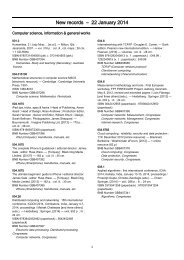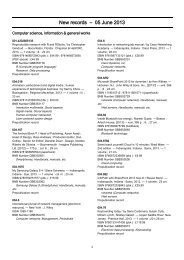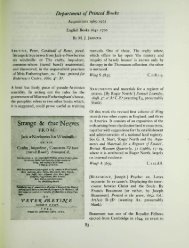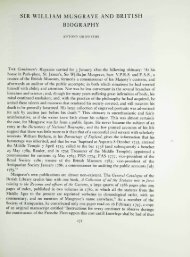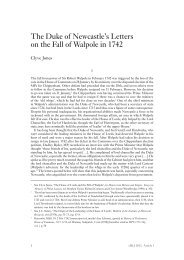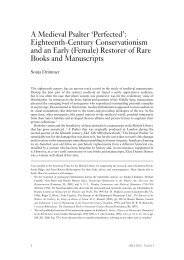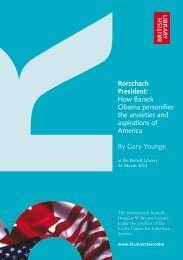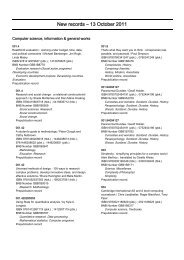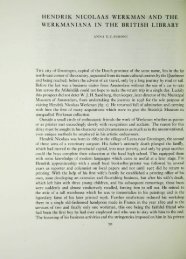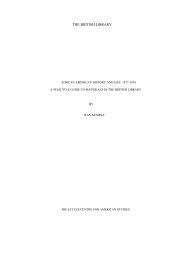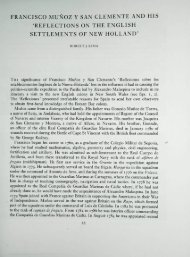YIDDISH MANUSCRIPTS IN THE BRITISH LIBRARY
YIDDISH MANUSCRIPTS IN THE BRITISH LIBRARY
YIDDISH MANUSCRIPTS IN THE BRITISH LIBRARY
You also want an ePaper? Increase the reach of your titles
YUMPU automatically turns print PDFs into web optimized ePapers that Google loves.
British Museum {now British Library), under the<br />
headings ' Belles-lettres: Drama: Judaeo-<br />
German' and 'Belles-Lettres: Novels: Judaeo-<br />
German', and also the indexes to Van Straalen's<br />
unpublished Gatalogue of Hebrew Printers {ca.<br />
1500 ~ ca. igoo) as represented in the holdings of<br />
the British Museum [now British Library), index<br />
5: 'Printers of languages other than Hebrew:<br />
Jewish languages: Yiddish', listing some forty<br />
printers.<br />
5 On the history of the Yiddish language, see Max<br />
Weinreich, Geshikhte fun der yidisher shprakh<br />
[History of the Yiddish Language], 4 vols. {New<br />
York, 1973), and the partial English version<br />
which excludes the notes, History of the Yiddish<br />
Language, trans. S. Noble and J. A. Fishman<br />
(Chicago and London, 1980). Much Yiddish<br />
linguistic literature has been recorded in B.<br />
Borochov, 'Di Bibliotek funem yidishn filolog:<br />
fir hundert yor yidishe shprakh forshung',<br />
reprinted in his Shprakh-forshung un literaturgeshikhte,<br />
ed. N. Meisel [Mayzel] {Tel Aviv,<br />
1966), pp. 76-136 (a second, unpublished, part<br />
of the 'Bibliotek' is said to be preserved in<br />
manuscript at the YIVO Institute in New York);<br />
K. Habersaat, 'Materialien zur Geschichte der<br />
jiddischen Grammatik', Orbis, xi {1962), pp.<br />
352-68; idem, 'Zur Geschichte der jiddischen<br />
Grammatik: eine Bibliographische Studie', Zeitschrift<br />
fur Deutsche Philologie, lxxxiv {1965), pp.<br />
419-35, and lxxxvi (1966), p. 156; S. Birnbaum,<br />
Yiddish: A Survey and a Grammar (Toronto,<br />
1979)1 PP- 309-88 ('Bibliography'); J. G. Bratkowski,<br />
Yiddish Linguistics: a Multilingual Bibliography<br />
(New York and London, 1988); and<br />
D. M. Bunis and A. Sunshine, Yiddish Linguistics:<br />
A Glasstfied Bilingual Inde.x of Yiddish<br />
Serials and Gollections, igij-ig^S {New York<br />
and London, 1994).<br />
For surveys of Yiddish linguistic research, see<br />
H. P. Althaus, 'Yiddish', in Gurrent Trends in<br />
Linguistics, vol. ix (The Hague, 1972), pp.<br />
1345-82, and Dovid Katz, 'On Yiddish, in<br />
Yiddish, and for Yiddish: 500 years of Yiddish<br />
Scholarship', in M. H. Gelber (ed.). Identity and<br />
Ethos: A Festschrift for Sol Liptzin on the<br />
Occasion of His 8s th Birthday (New York, 1986),<br />
pp. 23-36. The generally accepted view that<br />
Yiddish is a variety of High German with<br />
significant Slavic and Hebrew-Aramaic components<br />
has recently been challenged by Paul<br />
Wexler's theory that Yiddish is a Slavic language.<br />
'Judaeo-Sorbian', which has been relexified<br />
from High German. See his 'Yiddish-the<br />
Fifteenth Slavic Language: A Study of Partial<br />
Language Shift from Judeo-Sorbian to German',<br />
International Journal of the Sociology of<br />
Language, xci {1991), pp. 9-150, and Ms more<br />
recent - and more controversial - The Ashkenazic<br />
Jews: A Slavo-Turkic People in search of<br />
a Jewish Identity {Columbus, Ohio, 1993).<br />
6 The Got fun avrom ('God of Abraham') prayer<br />
recited at home by women at the close of the<br />
Sabbath is one striking exception, as is indeed<br />
the entire tkhines genre, a personal rather than a<br />
communal prayer form. The Yiddish sidur<br />
{* prayer book'), such as that translated by Joseph<br />
ben Yakar (Ichenhausen, 1544), and mahzor<br />
{*holiday prayer book'), such as the British<br />
Library's Add. MS. 27071, seem to have been<br />
primarily for home use. On women's liturgies in<br />
Yiddish, see Solomon Freehof, 'Devotional<br />
Literature in the Vernacular', GGAR Yearbook,<br />
xxxiii (1923), pp. 375-424; Dinse, op. cit., pp.<br />
84-91 and 190-3; Devra Kay, 'An Alternative<br />
Prayer Canon for women: the Yiddish Seyder<br />
Tkhines', in Julius Carlebach (ed.), Zur Geschichte<br />
der jiidischen Frau in Deutschland (Berlin,<br />
1993), pp. 49-96 (with bibliography of editions);<br />
and Jennifer Breger, 'Women's Devotional<br />
Literature: An Essay in Jewish Bibliography'^<br />
Jewish Book Annual, Hi (New York, 1994-1995),<br />
pp. 73-98. On prayer in Yiddish, see David E.<br />
Fishman, 'Mikoyekh davenen af yidish: a bintl<br />
metodologishe bamerkungen un naye mekoyrim'<br />
[' Concerning Prayer in Yiddish: Methodblogical<br />
Comments and New Sources'], Yivo Bleter,<br />
N.S., i {New York, 1991), pp. 69-92 (in Yiddish);<br />
and J. Baumgarten, Introduction a la litterature<br />
yiddish ancienne {Paris, 1993), pp. 319-62 {'Prier<br />
en langue vulgaire').<br />
7 See in this respect Lewis Glinert's 'Hebrew-<br />
Yiddish Diglossia: Type and Stereotype Implications<br />
of the Language of Ganzfried's Kitzur\<br />
International Journal of the Sociology of Language,<br />
lxvii {1987), pp. 39-55- On the knowledge<br />
of Hebrew in Eastern Europe, cf. S. Stampfer,<br />
'What did it mean to know Hebrew in Eastern<br />
Europe.^', in L. Glinert {ed.}, Hebrew in Ashkenaz<br />
{Oxford, 1993).<br />
8 An exemplary conversation in Ashkenazic<br />
Hebrew between two Yiddish-speaking {!) merchants<br />
('Drittes Gesprach, Zwischen zweyen<br />
Handels-Juden') is reproduced in Bibliophilus'



